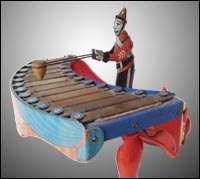By Martin A. Roenigk

Ever since discovering the Wolverine Zilotone several years ago, I have been fascinated by this ingenious musical toy of the Depression years. The toy combines the mechanical attributes of the early piano playing automatons with the convenience and variety of music provided by disc musical boxes. While not entirely successful, and neither the complexity of mechanical action nor the quality of music comes anywhere near that of its illustrious forebears, it is nevertheless a delightful toy.
The Zilotone was invented by Howard N. Barnum of Cleveland, Ohio. On October 7, 1930, he received US Patent No. 1,777,712 for his “musical toy”. The design itself was quite simple. The clown plays the Xylophone with two basic movements: 1) an up and down stroke of its arms to strike the various bars, and 2) a sideways motion of the entire body to select the proper note. In Barnum’s patent illustration, the various mechanical parts and their assembly are illustrated. In essence, a rod rides up a spiral track and then drops off, this in turn causes the arm of the figure to rise and then drop, striking a note with each turn of the shaft driven through a train of gears from the spring arbor. Interchangeably attached to the spring arbor is a cam plate that operates via a cam follower and a rack and pinion arrangement to turn the figure back and forth, positioning the hammer over the desired note in the tune sequence.
The final production model was considerably simplified and improved over the original patent, principally by riveting a second serrated disk to the cam plate–each serration acting through simple levers on a spring loaded rod that runs through the body of the figure–and moves the arms, and thus the striker, up and down. This has the great advantage of permitting phrasing in the music as wherever a tooth is not cut on the serrated disk a pause or rest will occur. These are synchronized with the notes selected by the contours of the cam disk to which the serrated disk is riveted.
The production xylophone has 12 notes, C-G, A-G, versus seven indicated on the original patent drawing. The motive power is a large spring motor that is hand wound and which drives the disk, which in turn drives the clown. The model is entirely of metal, brightly lithographed, and weighs two pounds.
Given model No. 48, the Zilotone was produced by the Wolverine Supply and Manufacturing Company in their Pittsburgh, Pennsylvania factory complex. Although production records were destroyed in their 1970 move to Booneville, Arkansas, the president of Wolverine, James L. Lehren, was helpful in providing background information.
Wolverine was founded in 1903 by B.F. Bain of Wolverine, Michigan. In 1906, Mr Lehren’s father joined the company as sales manager, and Mr. Lehren, joined the company in 1938. During the period of the 1920s through the 1940s, the company produced a number of tin mechanical toys that have delighted toy collectors ever since. Noted for their complex mechanical actions and sturdy metal construction, these included sand- and marble-activated toys, tin wind-up toys, and a number of musical toys, such as the No. 27 Drum Major, No. 49 Educational Chimes, and No. 50 Semi-chromatic Chimes. Today, at their 600,000-square foot plant in Arkansas, the company remains an important manufacturer of children’s toys and games.
The Zilotone was introduced in 1929 and was last catalogued in 1935. When first sold the Zilotone was priced at $2.50 and included a set of six tune discs. Although the price changed little over the following six years, the number of disks included declined from six to three. Optional sets of disks were available at three for .50 cents. There were nine disks available:
200 Wearing of the Green
201 My Bonnie Lies Over the Ocean
202 Good Night Ladies
203 Listen to the Mocking Birds
204 Silent Night
205 Yankee Doodle
206 Sidewalks of New York
207 My Old Kentucky Home
208 Farmer in the Dell
In 1930, disks 203-208 were included, and 200-202 was the only optional set, while in 1935 disks 206-208 were included, with 200-202 and 203-205 were offered separately.
A colorful piece of sales literature used during the early years takes considerable liberties in describing “The Outstanding Musical Novelty of the Season”. Anyone who has ever heard even a properly working Zilotone would have to take exception to the statements that the tones “is clear and harmonious. Each note is full-bodied, rich and true to the melody rendered.” The tunes are clearly recognizable, however, and the music is a delight to listen to when one accepts the toy as the mass-produced item that it is. I have even been told how to tune the notes, but I won’t bore you with the details.
It is not known how many Zilotones were actually sold, but they are rather difficult to find today. This suggests that production was not great, perhaps due to the dual obstacles of a high price ($2.50 vs the average price of $1.50 for toys in the Wolverine line) and the depression economy at the time of their production.
The concept of toy automaton playing a xylophone remained popular and a number of toys of this genre were imported from Japan in the 1950s and 1960s. These toys were battery operated and limited in repertoire to a single tune. These battery operated toys are the same basic principle as the Wolverine Zilotone. Riveted together are two disks–one with a template-like edge directing the back and forth motion of the body while the other, with a serrated edge, directs the up and down motion of the arm/striker. The major difference is that the disks are driven electronically rather than by spring-wound motor. One can only wonder if the Japanese designer, when working out his automatic xylophone had a Wolverine No. 48 on his desk.
